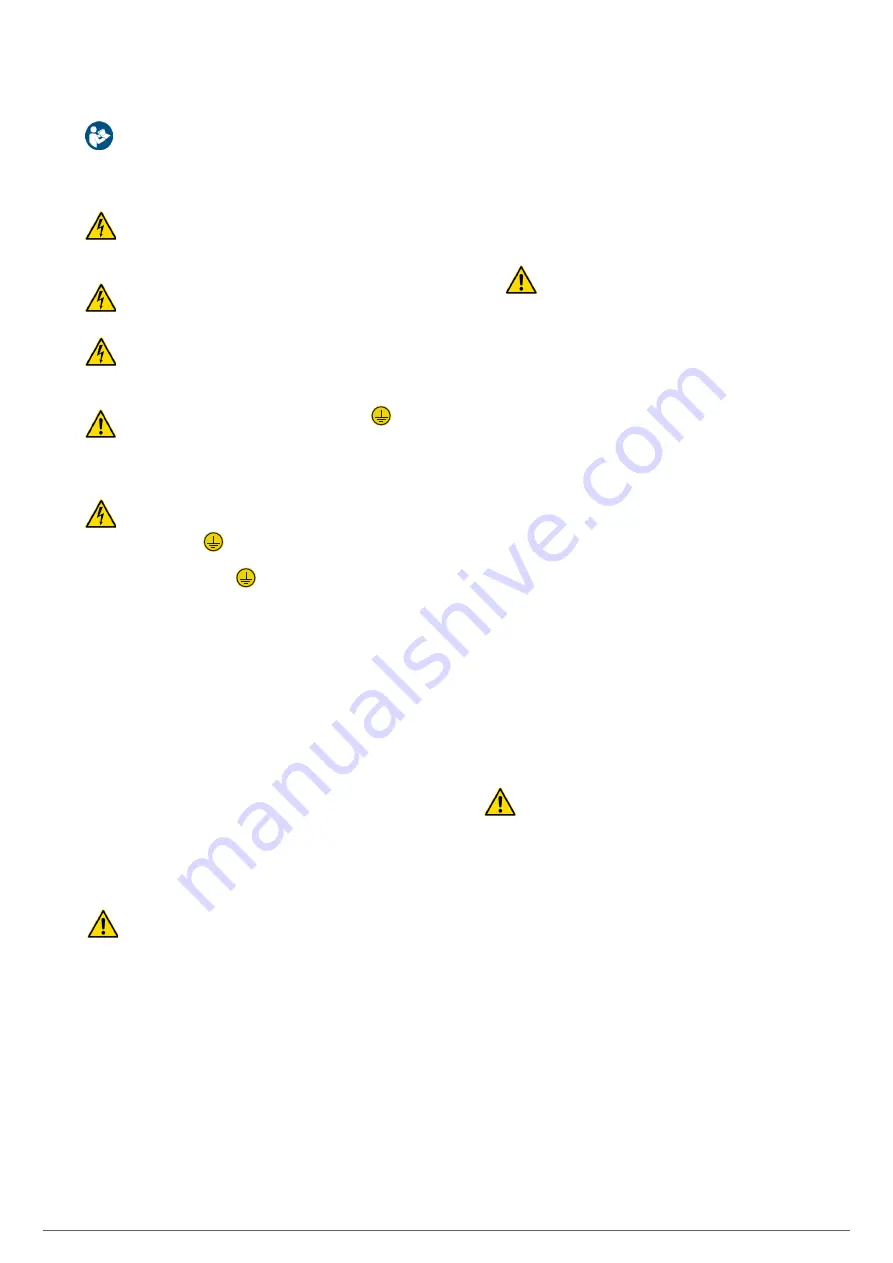
14
SALICRU
5. INSTALLATION.
•
Read and respect the Safety Information, described in
Chapter 2 of this document. Failure to obey some of the
instructions described in this manual can result in a serious or
very serious accident to persons in direct contact or in the vicinity,
as well as faults in the device and/or loads connected to it.
•
All of the device’s connections, including those related to
control (interface, remote control, etc.), should be made
with all of the switches in standby and without mains power
present (UPS power supply line disconnector set to ‘Off’).
•
It should never be forgotten that a UPS is a generator of
electrical energy, and as such, the user must take all nec-
essary precautions against direct or indirect contact.
•
The battery circuit is not isolated from the input voltage.
Dangerous voltages can occur between the terminals of
the battery bank and the earth. Check that no input voltage exists
before handling them.
•
All of the contacts or specific earth terminals
(
)
of the
plugs, sockets and/or connectors of the device’s input or
output are electrically connected to each other, with the protec-
tion cable extended to the loads when connecting them to the
UPS.
•
As the device has class I protection against electric
shock, it is essential to install a protective earth con-
ductor (connect earth
).
The socket that supplies power to the device must have a prop-
erly connected earth cable
(
)
.
5.1. RECEPTION OF THE DEVICE.
•
Any handling of the device must be carried out in accordance
with the weights shown in the technical specifications according
to the model, indicated in Chapter 9. ‘Annexes’. Pay attention
to section 1.2.1. of the EK266*08
‘Safety instructions’
in all
matters relating to the handling, movement and siting of the unit.
5.1.1. Inspection.
•
On reception of the device, check that it has not been damaged
during transportation (knocks, falls, etc.) and that the character-
istics of the device correspond to those on the order. To do so,
it is recommended to unpack the UPS and carry out an initial
visual inspection.
•
If it has been damaged, notify your supplier or, in their absence,
our company.
Never start up a device if it has been externally damaged.
•
Also check that the information on the label affixed to the pack-
aging matches that specified on the order, for which it will be
necessary to unpack the device (see Section 5.1.2). If there are
discrepancies, report the issue as soon as possible, quoting the
device’s manufacturing number and any delivery note references.
5.1.2. Unpacking.
•
The packaging of the device consists of a cardboard box, ex-
panded polystyrene [EPS] or polyethylene foam [EPE] corners,
polyethylene cover and strapping, all of which are recyclable
materials; consequently, if it requires disposal, it must be car-
ried out in accordance with current laws. We recommend
keeping the packaging in case it needs to be used in the future.
•
Proceed as follows:
Cut the straps around the cardboard box if any.
Remove the accessories (cables, documentation, etc. )
Remove the device or battery module from the box. This may
require the help of another person depending on the weight
of the model.
Remove the protective corners from the device and the
plastic bag.
Do not leave the plastic bag within the reach of chil-
dren to avoid the danger of suffocation.
Inspect the device before proceeding and, in the event of
finding damage, contact the supplier or, failing that, our firm.
5.1.3. Checking the contents.
•
Check the contents of the packaging. The contents will vary de-
pending on whether you are inspecting a UPS or battery module.
Device:
–
The device itself.
–
Quick guide on paper.
–
Information for warranty registration.
–
1 USB cable.
Battery module:
–
The module itself.
–
Information for warranty registration.
–
1 cable for connection between the device and battery
module or between modules.
•
Once the reception is completed, it is advisable to re-pack the
UPS until it is put into service in order to protect it against me-
chanical shock, dust, dirt, etc.
5.1.4. Storage.
•
The device should be stored in a dry, ventilated location pro-
tected from rain, dust, water splashes and chemical agents. It is
advisable to keep the device and battery unit/s in their original
packaging as it has been specifically designed to ensure max-
imum protection during transportation and storage.
•
For devices that contain Pb-Ca batteries, the charging
times indicated in Tab. 2 of document EK266*08, deter-
mined by the temperature to which they are exposed, must be
respected, otherwise the warranty may be invalidated.
•
After this period, connect the device to the mains together with
the battery unit if applicable, start it according to the instruc-
tions described in this manual and charge for 12 hours.
•
Then shut down the device, disconnect it and store the UPS and
batteries in their original packaging, noting the new date for
recharging the batteries on the respective label.
•
Do not store the devices where the ambient temperature ex-
ceeds 50ºC or drops below -15ºC, as this may cause degradation
of the electrical characteristics of the batteries.
5.1.5. Transfer to the installation site.
•
Although the weight of the device is not excessive, it is rec-
ommended to move the UPS by forklift, pallet jack or the most
appropriate means of transportation considering the distance to
the installation site.
If the distance is considerable, it is recommended to transport
the device in its packaging to the installation site and then un-
pack it there.















































